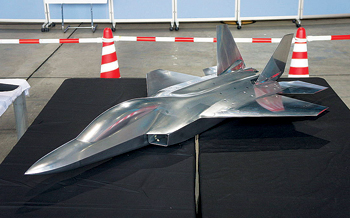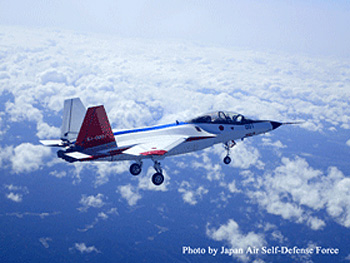INDIAN ARMED FORCES CHIEFS ON
OUR RELENTLESS AND FOCUSED PUBLISHING EFFORTS

SP Guide Publications puts forth a well compiled articulation of issues, pursuits and accomplishments of the Indian Army, over the years

I am confident that SP Guide Publications would continue to inform, inspire and influence.

My compliments to SP Guide Publications for informative and credible reportage on contemporary aerospace issues over the past six decades.
Japanese Stealth Fighter
The Japanese defence industry has been unshackled from the national policy of pacifism and has received the much needed impetus to develop weapon systems and military aircraft.
 |
By Air Marshal B.K. Pandey (Retd) Former Air Officer Commanding-in-Chief of Training Command, IAF |


On Friday, April 22 this year, the Advanced Technology Demonstrator (ATD) X2 "Shinshin", designed, developed and manufactured by Mitsubishi Heavy Industries (MHI), Japan’s largest military contractor, completed its maiden flight successfully. The ATD X-2 which reflects the growing ambitions of the Japanese aerospace major, is the prototype of a stealth combat aircraft, the first such platform to be made in the country. As its name suggests, the X-2 is only a technology demonstrator. Further research and development by the original equipment manufacturer on the X-2 will follow in the years ahead with the ultimate aim of producing by 2030, a new stealth fighter of the sixth-generation for the Japan Air Self Defence Force (JASDF) which will possibly be designated as the F-3. This may involve collaboration with the US aerospace industry, a decision that is yet to be taken. Concept designs of this future aircraft indicate two possible options; one has striking similarity to the F-22 Raptor and the other appears to be a tail-less delta, somewhat similar in appearance to the Boeing F-A-XX, a fighter version of the supersonic B-2 bomber. The X-2 being only a technology demonstrator will not be mass produced. The final version developed from the ATD X-2, the F-3, will, in all likelihood, be completely different in appearance and characteristics.
There is however considerable uncertainty in the project at this point in time. As per the Ministry of Defence of Japan, the final decision on whether the stealth fighter would be developed domestically or in collaboration with a global aerospace major in all likelihood from the US. If things do not proceed at a satisfactory pace for some reason, Japan may opt to procure a contemporary combat aircraft product from abroad, once again possibly from the US.
The Japanese government was in for a rude shock when the US refused to oblige them with the supply of the F-22 Raptor.
Japan in now the fourth nation in the world to manufacture and test-fly its indigenously produced stealth combat jet. The first stealth fighter aircraft of the world that took to the skies in the 1980s, was designed, developed and manufactured by the American aerospace industry. This was followed by Russia in 2010 and by China a year later. However, a common thread in stealth fighter programmes in different countries is that all have suffered from technical glitches and delay. This was the case with the Japanese programme as well. However, the launch of the ATD X-2 is being regarded as a major success for the modest domestic military aerospace industry of Japan whose growth had been somewhat stunted on account of postwar restrictions and even denials in the regime of military aerospace technology. Incidentally, so far, the US is the only country that has employed stealth combat jets in actual operations.
Historical Perspective
During World War II, Mitsubishi, the central player in the Japanese aerospace industry, had produced the dreaded and legendary single engine fighter aircraft known as the “Zero”. However, Japan emerged from World War II totally devastated and left with no choice, as an ally of the United States of America (USA). Thereafter, in due course, Japan rose to be a global economic power largely through its own efforts; but its military muscle was intimately influenced by the US that provided its Air Force with the latest combat aircraft such as the F-104 Starfighter, the F-4 Phantom and the F-15 Eagle. As for indigenous capability, Japan developed the F-2, the design of which was based on the General Dynamics F-16 Fighting Falcon and did not have stealth capability. Japan has constantly been under pressure from the US government not to develop its own fighter jets.
The Japanese government was in for a rude shock when the US refused to oblige them with the supply of the F-22 Raptor, fifth-generation fighter aircraft on the grounds that technology built into the platform in question was far too sensitive to be exported even to allies. Plans of the JASDF for the replacement of the fleet of 190J F-15 Eagle with the F-22 Raptor thus went awry creating a serious dilemma for Japan especially in the context of the growing strength and capability of air power and belligerence of China in the region. Japan was thus left with no choice but to develop its own advanced combat aircraft. As such, work on the development of the ATD X-2 at MHI commenced in the year 2000 and in 2005, the design was finalised and frozen for a while. Work on the project was resumed in 2009 and the maiden flight was scheduled for 2014, but problems with the control system for thrust vectoring led to a two-year delay. Meanwhile, in 2011, Japan initiated the procurement of 42 of the fifth generation F-35A Lightening II aircraft through the Foreign Military Sales programme of the US.
Technological Challenges
Compared to the fifth generation F-35 developed by Lockheed Martin Corporation of the US, the ATD X-2 is a much smaller aircraft. It is powered by two low-bypass turbofan engines manufactured by Ishikawa Heavy Industries, each generating five tonnes of thrust. Together, the two engines can deliver a maximum thrust of ten tonnes which is only 25 per cent of that delivered by the two engines of the F-35. It is understood that Japan has intentions to develop a new engine capable of delivering higher thrust to power the F-3 and enhance its performance to come close to that of the F-35. However, developing a new generation combat aircraft is no easy task even for Japan which is a technologically advanced nation. Apart from the power plant, modern state-of-the-art avionics, on-board computers, advanced software, sophisticated flight control systems and the capability to carry a wide range of weapon systems, have, over the years, become infinitely complex, making their seamless integration a challenging task for aircraft designers and manufacturers. The F-35 that has been under development for over 20 years continues to be afflicted with technological issues. The task before the Japanese aerospace industry therefore is not likely to an easy one.
Politico-Military Compulsions
The timing of the successful test flight by the ATD X-2 is significant particularly from the point of view of the evolving politico-military scenario. China is moving forward at a rapid pace with its own programmes to develop stealth fighters. The Chengdu J-10, the first stealth fighter aircraft produced by the Chinese aerospace industry, has already been inducted into service. This is likely to be followed in the near future by the Chengdu J-20 Black Eagle and the Shenyang J-31 (F-60) built by the Aviation Industry Corporation of China (AVIC). The export version of this aircraft is known as the FC-31. It closely resembles the F-35 and is meant for foreign customers who do not have access to US products. Both fifth generation stealth fighters in different versions are currently under development in China . The FC-31 was showcased for the first time outside China at the Air Show in Dubai in November last year.
South Korea in partnership with Indonesia, is developing KF-X, an advanced multirole fighter with stealth features for the Republic of Korea Air Force and the Indonesian Air Force. Japan as one of the major economic powers in the region obviously cannot be left behind in the race to develop new generation combat aircraft. Besides, of late China has been increasingly aggressive, creating artificial islands in the South China Sea, building military airbases on some of these and is ramping up its maritime and aerial capabilities in the region. North Korea is forging ahead with its menacing nuclear programme which is another threat dimension for Japan. All these developments make it necessary for Japan to shift its military-industrial complex into high gear and achieve higher levels of self reliance in the production of defence equipment. Japan regards the capability to attain air supremacy in war as being crucial for national security.
The Way Ahead
Fortunately, with the easing of post-war restrictions in 2014 by Prime Minister Shinzo Abe’s government on the nation’s military and lifting of arms export ban, the Japanese defence industry has been unshackled from the national policy of pacifism and has received the much needed impetus to develop weapon systems and military aircraft in collaboration with her allies as also remain abreast of the latest advances in technology. The F-3 will in due course hopefully close the capability gap with China and Russia. But what is more relevant is that the experience gained with the ATD X-2 programme will be of immense value in future projects for Mitsubishi as also the 200 other smaller companies of the Japanese aerospace industry that participated in the development of the prototype of the stealth fighter.





